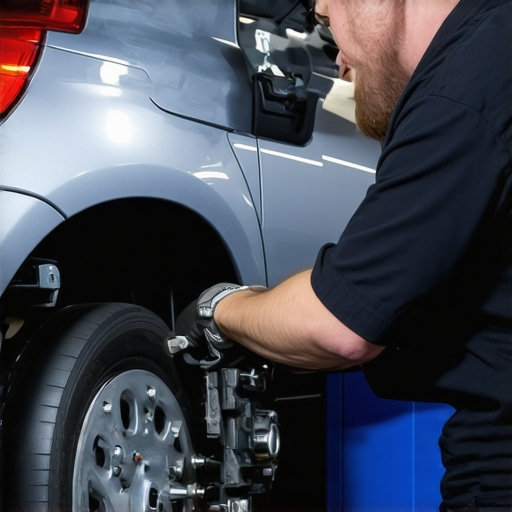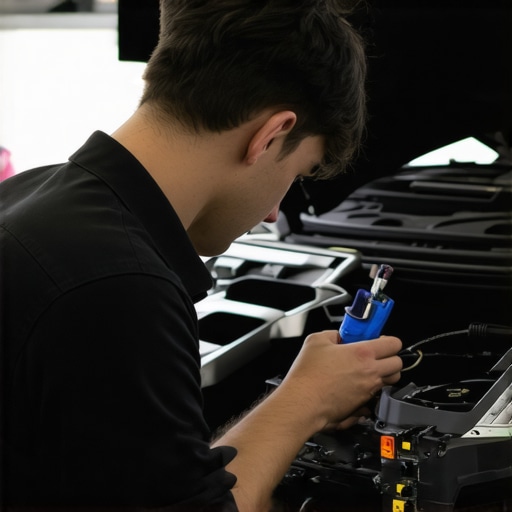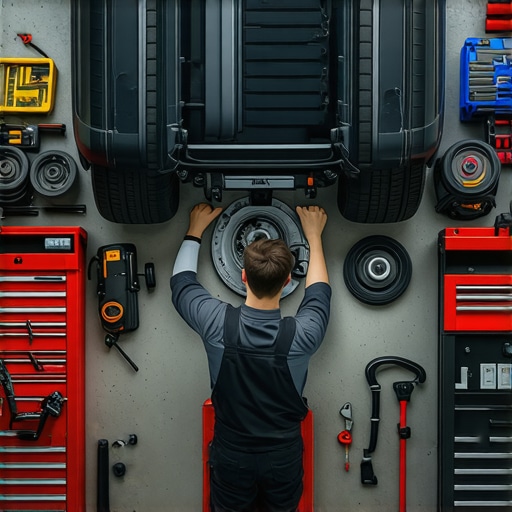My Journey to Safer Driving Starts with Expert Brake & Transmission Care
Last year, I found myself unexpectedly needing to replace my brake pads just before a long road trip. That experience made me realize how vital reliable brake and transmission systems are for safe driving. Since then, I’ve committed to understanding and maintaining these crucial components, especially as we head into 2024 with new safety standards and vehicle technology.
Why Are Expert Brake & Transmission Services So Essential?
From my personal experience, I’ve learned that regular maintenance by trusted professionals can prevent costly repairs and, more importantly, keep me safe on the road. Expert services ensure that my brakes respond promptly and my transmission shifts smoothly, which are essential for confident driving in any weather or traffic condition. I always consult authoritative sources like the National Highway Traffic Safety Administration for the latest safety tips, reaffirming that proactive maintenance is key to safety.
The Personal Touch: How I Know It’s Time for Service
One thing I’ve learned is to listen to my vehicle. Squeaking brakes or delayed shifting are signs that expert intervention is needed. I also schedule regular check-ups, especially before long trips or seasonal changes. My mechanic at CollisionRenew always advises that preventive care can save lives and money.
Can I Maintain My Brake & Transmission Systems Myself?
What simple checks can I perform to catch issues early?
While professional service is irreplaceable, I do perform basic checks like ensuring brake fluid levels and listening for unusual noises. However, complex diagnostics require expert tools and knowledge. For detailed guidance, I refer to auto repair tips that emphasize regular professional inspections for peace of mind.
If you’re like me, you want your vehicle to be a reliable partner on the road. Regular brake and transmission service from qualified technicians can dramatically improve safety, especially as vehicle technology advances in 2024. I encourage everyone to prioritize these essential checks and consult with trusted experts to keep your driving safe and smooth.
Feel free to share your own experiences or ask questions below — I’d love to hear how you’re ensuring your vehicle’s safety this year!
Unlocking the Secrets to Prolonging Your Vehicle’s Brake & Transmission Lifespan
Maintaining your vehicle’s brake and transmission systems isn’t just about avoiding repairs—it’s about ensuring your safety and confidence on every journey. As vehicles become more sophisticated in 2024, understanding the nuances of expert maintenance becomes even more critical. Regular professional inspections, combined with mindful driving habits, can significantly extend the life of these vital components.
How Do Modern Vehicle Technologies Influence Brake & Transmission Maintenance?
With the advent of advanced driver-assistance systems (ADAS) and electronic transmission controls, the landscape of vehicle maintenance is evolving. These innovations can both complicate and simplify diagnostics. For instance, vehicles now often feature adaptive braking systems that require calibration and software updates, which only certified technicians can perform. Similarly, modern transmissions, especially CVTs and dual-clutch systems, demand precise adjustments that go beyond basic fluid changes.
According to a comprehensive review by the Consumer Reports, keeping abreast of these technological changes is essential for effective maintenance. Regular visits to trusted auto repair experts ensure your vehicle’s systems stay aligned with manufacturer specifications, preventing costly malfunctions down the line.
Could Overlooking Minor Signs Lead to Major Failures?
One of the most insightful questions an expert can ask is: “Are you paying attention to the subtle cues your vehicle gives you?” Often, early signs like a slight delay in shifting gears, unusual noises when braking, or a soft pedal can indicate underlying issues. Ignoring these signs might result in more severe problems such as transmission failure or brake failure, both of which compromise safety.
For example, a persistent squealing during braking can be a sign of worn-out brake pads or issues with the brake calipers. Addressing these early with help from specialists at CollisionRenew can prevent costly repairs and dangerous situations.
Moreover, routine checks like verifying brake fluid levels and listening for irregular sounds during shifts are simple yet effective practices. These checks act as early warning systems, alerting you to potential failures before they escalate.
What Are Practical Strategies for Enhancing Brake & Transmission Durability?
Beyond regular professional service, adopting good driving habits can make a significant difference. Avoiding aggressive acceleration and deceleration, reducing heavy loads, and steering clear of rough roads can lessen the strain on your vehicle’s systems. Additionally, periodic comprehensive inspections, especially before long trips or seasonal changes, ensure your vehicle remains in peak condition.
For in-depth guidance on maintaining overall vehicle health, explore auto repair tips that emphasize proactive care. These practices not only extend component life but also enhance safety and driving pleasure.

Image depicting a mechanic performing a professional brake and transmission inspection, emphasizing expert care for vehicle safety.
What Are the Hidden Nuances of Modern Brake & Transmission Maintenance?
Having spent years working closely with vehicle systems, I’ve come to realize that the intricacies of modern brake and transmission care go far beyond routine fluid changes. The evolution of vehicle technology, especially with the integration of electronic control units (ECUs) and adaptive systems, demands a more nuanced approach. For instance, some vehicles now feature regenerative braking systems or electronically controlled clutches that require specialized calibration — tasks that only highly trained technicians can perform effectively. This is why I always emphasize the importance of trusting experts who stay current with manufacturer updates and software diagnostics. As Consumer Reports highlights, staying ahead with advanced diagnostic tools is essential to prevent subtle issues from escalating into major failures.
How Can I Detect the Subtle Signs of Underlying Damage Before It Escalates?
One of the most valuable lessons I’ve learned is to pay close attention to the small, often overlooked cues that my vehicle gives. For example, a slight vibration during braking or a minor delay in shifting gears might seem insignificant at first, but these can be precursors to more serious problems. Regularly listening for squeals, grinding noises, or feeling a soft brake pedal can reveal early warning signs. Addressing these signs promptly, with the help of trusted specialists at CollisionRenew, can save you from costly repairs and potentially dangerous situations. I’ve found that proactive attention to these details not only extends the lifespan of my vehicle components but also enhances my peace of mind on the road.
How Do Driving Habits Impact the Longevity of Brake & Transmission Components?
Beyond regular professional maintenance, my personal driving habits have a profound impact on how long my vehicle’s brake and transmission systems last. I’ve learned to avoid aggressive acceleration and sudden deceleration, which put undue stress on these vital parts. Using engine braking instead of relying solely on the brake pedal, especially when descending long slopes, helps preserve brake pad thickness and caliper health. Similarly, shifting gears smoothly and avoiding abrupt changes in speed reduces strain on the transmission. Additionally, I make it a point to schedule comprehensive inspections before long trips or seasonal transitions, aligning with the advice from auto repair tips. These practices, combined with mindful driving, significantly contribute to the durability of my vehicle’s critical systems.
How Will Emerging Vehicle Technologies Reshape Maintenance Strategies?
The rapid adoption of advanced driver-assistance systems (ADAS), hybrid powertrains, and electric vehicles is transforming how we approach brake and transmission care. For example, regenerative braking in hybrids and EVs not only reduces wear but also necessitates specialized maintenance routines. The complexity of these systems means that traditional fluid changes are no longer sufficient; calibration and software updates are often required. According to Consumer Reports, staying informed about these technological shifts is crucial. Partnering with certified technicians who understand the nuances of modern vehicles ensures that your safety isn’t compromised by overlooked updates or calibration issues.
What Can I Do to Keep My Brake & Transmission Systems at Peak Performance Amidst These Changes?
In my experience, continuous education about your vehicle’s evolving systems makes all the difference. Regular visits to skilled auto repair shops, like CollisionRenew, provide the necessary diagnostics and adjustments. Additionally, adopting good driving habits, such as gentle acceleration, gradual braking, and avoiding overloaded loads, can extend component life significantly. I also recommend exploring comprehensive maintenance plans tailored to your vehicle’s make and model, especially as newer technologies become standard. These proactive steps not only safeguard your investment but also keep you safe on every journey.

Image of a technician calibrating electronic brake and transmission systems, emphasizing the importance of expert maintenance in modern vehicles.
Deciphering the Complexities of Electronic Control Units in Modern Brake & Transmission Systems
One of the most fascinating aspects of contemporary vehicle maintenance is understanding how electronic control units (ECUs) orchestrate the performance of brake and transmission systems. These sophisticated computers continuously monitor various sensors, adjusting parameters in real-time to optimize safety and efficiency. For example, modern anti-lock braking systems (ABS) rely on ECUs to prevent wheel lockup during sudden stops, a feature that requires precise calibration and software updates. Similarly, electronically controlled transmissions adapt to driving habits, demanding regular diagnostics to ensure seamless shifts and prolonged lifespan.
From my personal experience, I have seen how neglecting ECU updates can lead to inconsistent performance or even system failures. Staying current with manufacturer firmware updates through trusted technicians at CollisionRenew has been instrumental in maintaining my vehicle’s optimal operation. This proactive approach not only preserves safety but also prevents costly repairs derived from outdated software or calibration errors.
How Can I Detect Subtle Diagnostic Alerts Before They Escalate?
Advanced vehicles often display warning lights or subtle shifts in driving behavior that, if ignored, could lead to significant damage. For instance, a blinking ABS warning light or a slight delay in transmission response can be early indicators of underlying issues that require expert diagnosis. I’ve learned to pay close attention to these cues, which often necessitate specialized diagnostic tools available only at certified service centers. Consulting authoritative sources like Consumer Reports underscores the importance of timely intervention to avoid escalation.
Addressing these signs promptly with professional diagnostics at CollisionRenew has been my strategy for safeguarding my vehicle’s longevity and my safety on the road.
What Are Cutting-Edge Strategies for Future-Proofing Brake & Transmission Systems?
Adopting a forward-thinking approach involves integrating emerging maintenance techniques tailored to evolving vehicle technologies. For example, predictive maintenance systems utilize IoT sensors and machine learning algorithms to forecast potential failures before they occur. These innovations enable technicians to perform targeted repairs, minimizing downtime and costs. My experience aligns with insights from auto repair experts who emphasize the significance of embracing digital diagnostics and regular software updates.
Engaging with these advanced strategies ensures your vehicle remains resilient in the face of rapid technological change, safeguarding your investment and personal safety.
How Can I Leverage Expert Maintenance to Navigate 2024’s Vehicle Innovations?
Understanding the nuances of new vehicle technologies requires ongoing education and collaboration with specialists. I regularly consult with certified technicians at CollisionRenew to stay informed about system calibrations, software updates, and component longevity strategies. These partnerships have empowered me to proactively manage my vehicle’s health, ensuring that my brake and transmission systems perform reliably amid the technological advancements of 2024.
If you’re eager to deepen your expertise or share your personal maintenance journey, I invite you to engage with me. Together, we can navigate the evolving landscape of vehicle safety and performance, ensuring every drive is secure and smooth.
Things I Wish I Knew Earlier (or You Might Find Surprising)
1. The Subtle Signs Are Often Easy to Miss
Early warning signs like a soft brake pedal or slight delay in shifting can seem minor but often indicate underlying issues. Paying close attention to these cues has helped me prevent costly repairs and stay safe on the road.
2. Regular Professional Maintenance Is Irreplaceable
No matter how diligent I am, some diagnostics require expert tools and knowledge. Scheduling routine check-ups with trusted mechanics ensures my vehicle’s safety and longevity.
3. Modern Vehicle Technologies Demand Updated Care
With newer cars featuring advanced driver-assistance systems and electronic controls, staying current with software updates and calibration routines has become essential for optimal safety and performance.
4. Driving Habits Significantly Impact System Lifespan
Gentle acceleration, gradual braking, and avoiding overloads help preserve my brake and transmission systems. Mindful driving habits have extended the life of my vehicle components remarkably.
5. Emerging Tech Opens New Maintenance Opportunities
Predictive maintenance and IoT sensors are revolutionizing how we care for our cars. Embracing these innovations can prevent failures before they happen, saving time and money.
Resources I’ve Come to Trust Over Time
- National Highway Traffic Safety Administration: Their safety guidelines and latest updates keep me informed about vehicle standards and recalls, making me more aware of what my car needs.
- Consumer Reports: Their reviews and maintenance tips have helped me understand complex systems and choose the right service providers.
- Official Manufacturer Websites: For software updates and calibration routines, these sites are a reliable source of accurate information directly from the makers of my vehicle.
Parting Thoughts from My Perspective
Maintaining your vehicle’s brake and transmission systems in 2024 isn’t just about avoiding repairs—it’s about ensuring safety and peace of mind. Paying attention to subtle cues, embracing new technologies, and trusting expert services have transformed how I approach car care. If this resonates with you, I’d love to hear your own experiences or tips for keeping your vehicle in top shape. Share it with someone who might find it helpful, and let’s keep our journeys safe and smooth!

